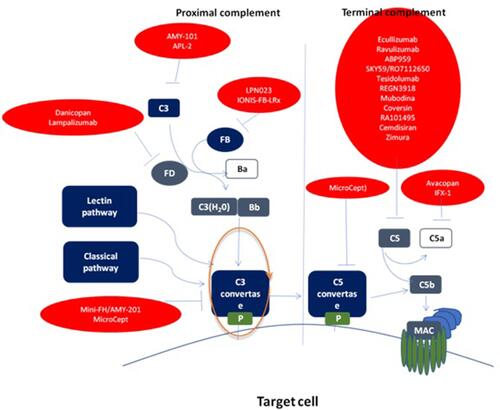Figures & data
Table 1 Summary of Novel Approved and Under Development Therapies in SCD
Figure 1 Complement activation and inhibition. The complement cascade has been traditionally considered to be activated by the classical, alternative and lectin pathway. The alternative pathway serves as an amplification loop for the lectin and classical pathway accounting for almost 80% of complement activation products. Spontaneous hydrolysis of C3 resulting from different triggers allows propagation of C3 convertase (C3bBb) and as a result the alternative pathway is constantly “on”. C3 convertase sustains the amplification loop together with factors B and D. Terminal complement pathway begins with propagation of C5 convertase which in turn cleaves C5 into C5a, a potent inflammatory mediator, and C5b; C5b together with C6-9 form C5b-9 (membrane attack complex/MAC), a cytolytic complex. Eculizumab, ravulizumab, ABP959, SKY59/RO7112650, tesidolumab, REGN3918, mubodina, coversin, RA101495, cemdisiran and zimura inhibit C5; AMY-101 and APL-2 inhibit C3 and C3 convertase activity; mini-FH/AMY-201 inhibits alternative pathway C3 convertase; LPN023 and IONIS-FB-LRx inhibit factor B; danicopan and lampalizumab inhibit factor D; mirococept inhibits C3 and C5 convertases; avacopan inhibits C5a receptor and IFX-1 C5a.

